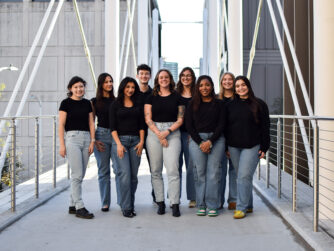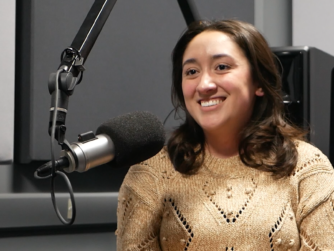Hi!
I am Cesar Perez, the director of “Crooked Power,” which is set to release this summer. I wanted to write this post because I need to tell you about a brilliant conference I attended over the weekend. The International Symposium on Online Journalism (ISOJ) hosted a panel about the future of audio storytelling, and let me just say: It is bright and exciting. The all-women, star-studded panel radiated experience and talent; and to a relatively new audio guy such as myself, it was truly inspiring.
Tamar Charney, editorial strategist and former NPR journalist and director, led the discussion about the future of audio journalism and social audio. She was joined by panelists Rebeca Ibarra from Insider’s “The Refresh,” Sarah Feldberg from the San Francisco Chronicle, Maggie Penman from the Washington Post’s “Post Reports” and Nina Gregory from Clubhouse.
The five women shared their audio experiences, challenges they’ve faced and tips for emerging audio reporters. All of the women agreed that the way people consume journalism has changed. Therefore, as Penman said, “We must meet [the people] where they are.” Feldberg added that by doing so, you can actually expand your audience and reach people who you wouldn’t normally think of as your readers.
One of the recurring themes of the panel was how intimate the medium is. Feldberg put it best when she said that podcasting allows you to — quite literally — bring community voices to your story.
On a similar note, Ibarra emphasized perhaps the best tip I got when I began reporting for audio. “Let people get comfortable talking about their stories,” she said. She followed her powerful quote by reiterating something my two bosses, who were by my side (Hi Katey and Quigley!), repeated until it stuck with me: set scenes. “Let your words paint a picture in the listeners mind” is what Quigley used to tell me and still, from time to time, does.
In fact, during one of the breaks we had, Quigley and I remembered his freshman-level class in which he taught me that very lesson that was now being repeated on an inspiring panel. I even reminded him of the picture he showed us in lecture. Full-circle, wholesome moment right there.
Now, let’s go back to what matters. Another point that the panelists stressed is how the medium allows for more transparent journalism to happen. Penman phrased it brilliantly by saying that through podcasting, journalists are able to “pull back the curtain” and let the audience in on the reporting process.
She further explained how through the technology we have today, we can have on-the-ground, impactful reporting anywhere and at any time. She mentioned how “Post Reports” was able to share a voice memo recording after a day’s worth of work by a journalist stationed in Ukraine. With what other medium would you be able to do such a thing? Hard to say.
Feldberg said that listening to a sound bite “is not the same [as] reading a quote.” And indeed, it is not. Sound brings the listeners in. It is immersive and engaging; there lies the power of audio storytelling.
Feldberg oversees production of “Fifth & Mission,” a podcast that embodies the “pull back the curtain” sentiment. It’s named after the location of the Chronicle’s newsroom, and it aims at creating relationships between the audience and journalists. Through sound, they intend to bring listeners into their headquarters.
Feldberg explained that the intimacy of audio allows readers to connect not only with the host of the show but also with journalists who share the stories they’ve reported on with the host. She said that “[journalists] become trusted people.” Having an intimate relationship founded on trust is perhaps the greatest asset a news organization can have.
At Insider, they are experimenting with innovative storytelling techniques. “The Refresh,” a show that has only been around for a month or so, is a “boundary pushing thing,” Ibarra said. They realized that with the current technology in podcasting, a normal podcast episode resembles the print version of a newspaper; after all, once the show is out, you cannot edit or “refresh” it. Therefore, Insider has put out this new show — which tries to resemble a homepage — that allows for updates to be uploaded to already published episodes. Once they have established such a system that works well enough, Ibarra said they are exploring how to share it with other organizations.
All the podcasters in the panel agreed that the hard part of podcasting is post-production. Recording is the somewhat easy part, especially with the technology we have at hand — literally. The pandemic, too, has made people more comfortable in talking over Zoom and recording the conversation.
If you are itching to be a podcaster, go for it! You can do it. If you are intimidated by editing, the hard part, you can try social audio. Penman said social audio is “the fun part without the hard part later.” Her fellow panelists agreed and grinned.
Nina Gregory, from Clubhouse, encouraged audience members to “go do it.” She said that with social audio, you can take risks and experience an invigorating process. And, as Feldberg said, who knows, maybe you can turn your social audio story into a podcast episode later, just as the Chronicle did with a Twitter Space about the omicron variant.
I am no expert on social audio, so I’ll step aside and allow someone with more experience on the medium than me to tell you all about it. In fact, you will be able to listen to the panel on isoj.org soon, where Gregory herself shared wonderful insight. I would encourage you to tune in. You might find something I missed.
With that, I say goodbye — for now.
Thanks to the amazing panelist for sharing their invaluable expertise and knowledge. Thanks to my bosses who attended the conference with me. And most of all, thanks to ‘Profe’ Rosental Alves and the amazing team at the Knight Center for Journalism in the Americas for making in-person ISOJ a reality once again.
Talk to y’all soon — literally!








